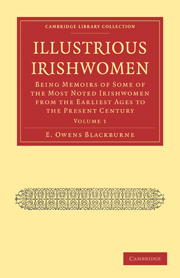 Illustrious Irishwomen
Illustrious Irishwomen LETTICE, BARONESS OPHALY
Published online by Cambridge University Press: 07 September 2011
Summary
Died, a.d. 1658
A DAUGHTER and heiress of the Geraldines, Lettice Digby, Baroness Ophaly, inherited the noble and fearless spirit of her race. She was granddaughter to Gerald, eleventh Earl of Kildare, and only daughter of Gerard, his eldest son, who died before his father. Created Baroness Ophaly, she was heir general to the house of Kildare, and inherited the barony of Geashill. She married Sir Robert Digby, of Coleshill, in the county of Warwick; he died in 1618, leaving the Baroness a widow with seven children.
With this family she returned to Ireland, and lived in the castle of Geashill, in the Queen's County. Here she resided for many years, honoured and respected by all. Although a woman of brilliant talents, she was content to live quietly, performing the duties of mother to her children, and a kind and considerate mistress to her household and tenantry. This state of affairs continued until the year 1641, when the country fell into a most disordered state. Civil war devastated the land, and when the rudeness of that most degraded period suggested the hope of finding an easy prey in the feebleness of an unprotected lady, her brutal assailants met with a resistance worthy of commemoration.
The rebels demanded admission to, and possession of, the castle of Geashill, a request which the Baroness stoutly refused.
- Type
- Chapter
- Information
- Illustrious IrishwomenBeing Memoirs of Some of the Most Noted Irishwomen from the Earliest Ages to the Present Century, pp. 104 - 109Publisher: Cambridge University PressPrint publication year: 2010First published in: 1877


